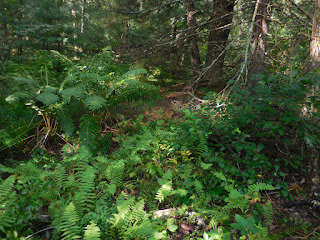 |
| Lygodium palmatum climbing on Osmundastrum frond. Windham County, Connecticut, August 13 2021. |
One of the most unusual native ferns in my area is Lygodium palmatum, the Hartford Fern or American Climbing Fern. The climbing ferns are about 40 species of Lygodium, the lone genus in the family Lygodiaceae, distantly related to the curly-grass ferns (family Schizaeaceae). The climbing ferns are mostly tropical, with a few representatives in north temperate regions, including Lygodium palmatum, the sole species of climbing fern native to the US.
 |
| Lygodium palmatum with fertile and sterile leaflets, climbing on Winterberry (Ilex verticillata). |
Climbing ferns are indeed vines--uniquely, I believe, among ferns--which twine around other plants in order to reach sunlight and position their spore-producing structures higher for more efficient spore dispersal. Perhaps even more peculiar than the vining habit of Lygodium, is the fact that the vines are not stems, but very long, indeterminately growing leaves (the only stem tissue in climbing ferns is the underground rhizome from which the twining leaves arise). The fronds grow from a meristem (growth point) at their tip, periodically producing new leaflets (pinnae). Some large tropical species of Lygodium have additional meristems at the base of each leaflet, which can grow out as new vining fronds, especially if the main growing point of the frond is severed. This growth form is a remarkable parallel to the organization of the entire shoot system--with shoot apical meristems, stems, leaves and axillary buds--of just about every other group of plants.
 |
| Lygodium palmatum, fertile leaflet underside with immature sori, in August. |
Mature Hartford Ferns bear two different types of leaflets. On the lower parts of the frond there are broad, palmate (hand-shaped) sterile pinnae, which are strictly there for photosynthesis, not reproduction. The more distal parts of the frond may bear fertile pinnae, which are more branched and end in many narrow pinnules. Fertile leaflets have sori on their undersides, which are clusters of minute sporangia, the capsules that shed spores in autumn.
 |
| Lygodium palmatum patch, with Marsh Fern (Thelypteris palustris). |
Hartford Fern is associated with wetlands with acidic soil; I have seen it in Red Maple swamp and river floodplains, generally in spots with dappled sun under a somewhat patchy tree canopy ("high shade" as wildflower gardeners say). Lygodium grows on hummocks, banks and other slightly elevated spots in wetlands, seemingly avoiding low places that would have standing water in spring. Associated plants include Cinnamon Fern (Osmundastrum cinnamomeum), Royal Fern (Osmunda regalis), Catbrier (Smilax rotundifolia) and the usual shrubs of acidic swampland such as Sweet Pepperbush (Clethra alnifolia) and Highbush Blueberry (Vaccinium corymbosum).
 |
| Lygodium palmatum habitat, Windham County, Ct. |
Red maple swamp with Cinnamon Ferns is not exactly an uncommon habitat in the Northeast; there are probably hundreds of acres of wetland that looks appropriate for Lygodium, in my town alone. But as far as I know, there are no Lygodium populations at all in my immediate area. Hartford Fern is geographically widespread, too, being native to most of the states east of the Mississippi. It's a bit of puzzle, then, just how rare our native climbing fern is; there are apparently fewer than five patches of it in all of New York state, for instance.
Part of the reason for Hartford Fern's rarity is thought to be the collection of the fern's evergreen fronds for Christmas decorations in the nineteenth century, which led to the state of Connecticut passing legal protections for the species in 1869, the first endangered plant legislation in the United States. Land clearance for agriculture and the flooding of wetlands by widespread construction of dams for mills probably also harmed Lygodium populations in New England. It's possible that there is some non-obvious reason, as well, why most semi-open wet woodlands are not actually suitable for Lygodium, despite looking similar to the vanishingly rare spots where Hartford Fern does grow. In any event, catching sight of our native climbing fern is a special and unfortunately quite uncommon occurrence.
--
A followup post covers propagating Hartford Fern from spores in cultivation.




